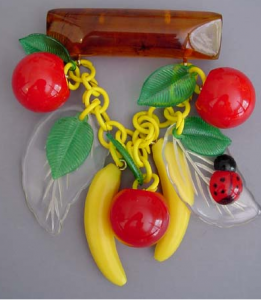 The auction firm Bonhams recently announced higher than anticipated prices for a single-owner collection of Bakelite and Lucite jewelry. Bakelite enthusiasts will be happy at the news Bakelite appears to have retained and even grown in value during a difficult economic time.
The auction firm Bonhams recently announced higher than anticipated prices for a single-owner collection of Bakelite and Lucite jewelry. Bakelite enthusiasts will be happy at the news Bakelite appears to have retained and even grown in value during a difficult economic time.
Bakelite jewelry, including Bakelite beads, has become popular with collectors in recent years. Bakelite is a plastic, developed by Dr. Leo H. Baekeland, and patented in 1909. Baekeland apparently discovered the plastic by accident while he was attempting to create a varnish. Bakelite was the first plastic made from synthetic polymers.
Some experts disagree about when the Bakelite boom actually occurred. Some say it was manufactured between 1907 and 1927 while others assert the really great boom in Bakelite occurred during the Great Depression when it was used to imitate tortoiseshell, coral, amber, ivory and other expensive gemstones. Various department stores from Sears to Cartier sold the popular costume jewelry in the 1930s.
It’s probably safe to say that Bakelite stayed popular until WWII when manufacturers switched over to war time products. After the war, technological advances in plastic made Bakelite obsolete.
Part of the reason for the disagreement may be that, as I understand it, Bakelite jewelry was produced without a manufacturer’s or maker’s mark, so it’s impossible to know who manufactured it. That means it’s hard to date it.
In any event, experts do agree that a number of dealers are offering what are called “fakelite” – fake Bakelite.
Here are some tips, culled from around the web, to determine if your Bakelite might be genuine.
- First look at the piece. It should have no seams or mold marks.
- Some experts recommend dipping the Bakelite into hot water and then sniffing it. Apparently the Bakelite emits a distinctive odor. (See below) Don’t dip in hot water if there are rhinestones in the piece.
- Some suggest dipping a cotton swab into 409, the household cleaner and then touching a small area of the piece where it won’t be visible when worn. If the piece is vintage Bakelite, a yellow stain will appear on the cotton swab. (Although I saw this advice from a number of dealers, it sounds as if it is a destructive test. Otherwise, why recommend testing on an area that won’t be visible? I’d stay away from this. Similarly, I’m not even going to repeat the advice I’ve seen about applying a hot needle to the jewelry.)
- Rub your fingers over the piece until it’s warm, then smell. The odor is “unforgettable,” according to one expert and identical to odor resulting from the hot water test.
- Tapping two pieces of Bakelite together will produce a distinct deep sound, quite unlike the higher pitched sound produced by tapping other plastics together.
Bakelite also changes color as it ages. According to Sherry Matsen, a Bakelite expert, the most common Bakelite colors were whte, brown, green and red. Over time, white often turns to butterscotch, light blue changes to forest green and pink turn to orange.
Pearl and bead stringers can and do produce fabulous jewelry from vintage Bakelite. I’ve seen pendants, brooches, beads and other items incorporated into really good looking jewelry. It’s also important to have at least a passing familiarity with Bakelite as your clients can and will ask about it.

